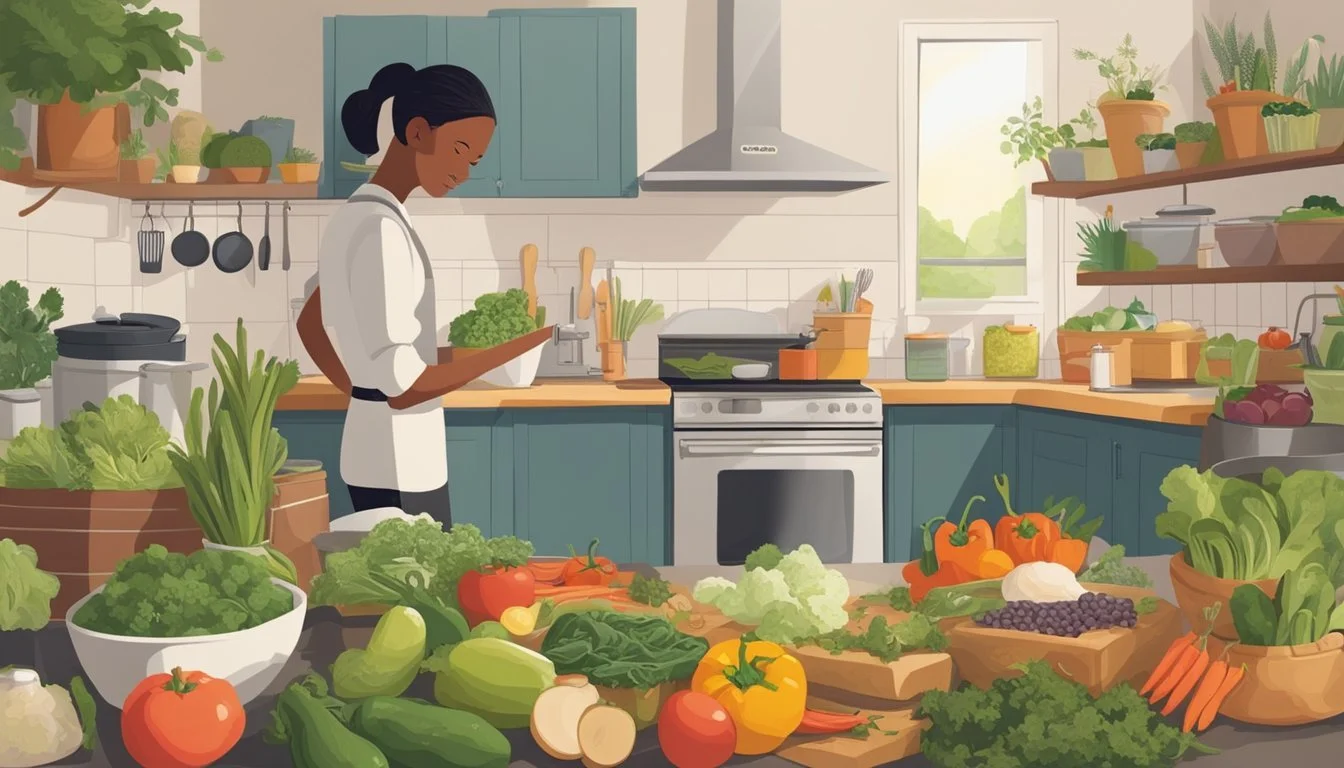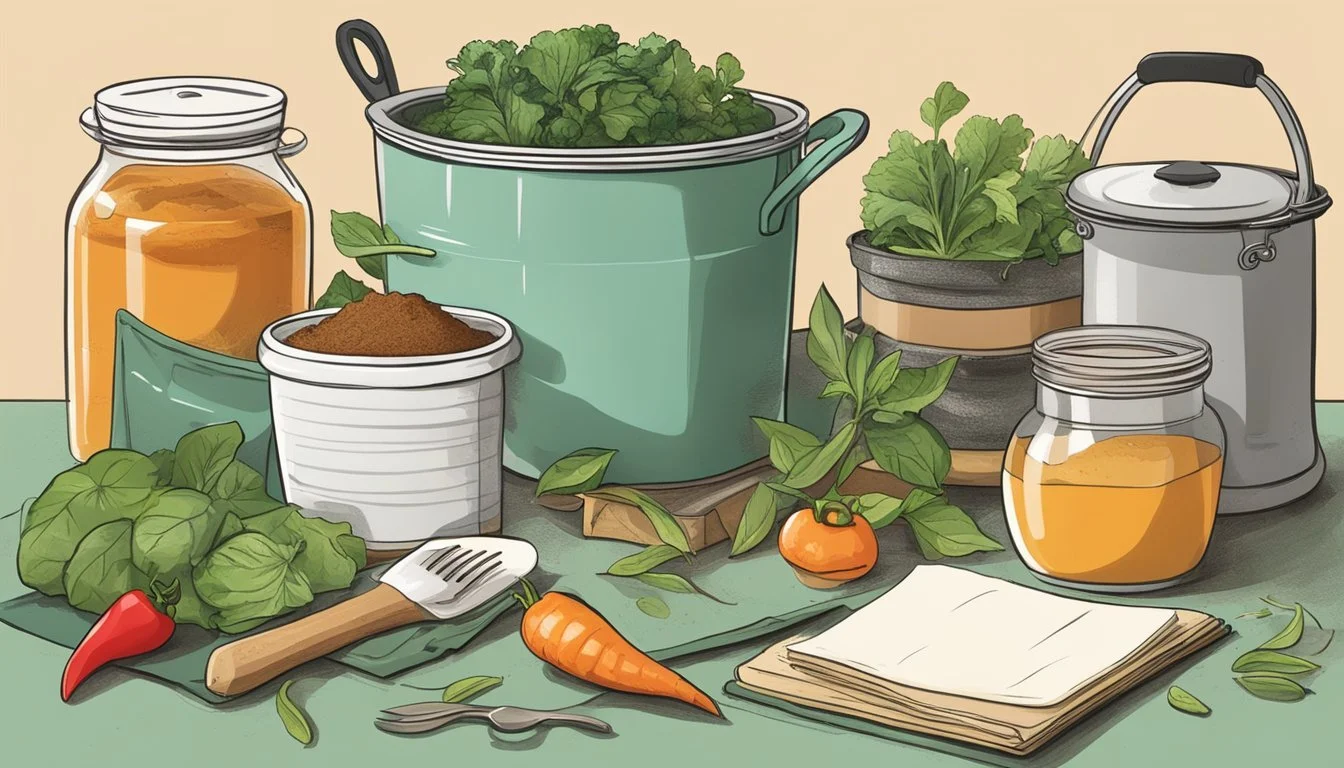Swicy and Sustainable
Mastering Eco-Friendly Sweet-Spicy Culinary Techniques
The fusion of sweet and spicy flavors, nicknamed 'swicy,' has been tantalizing taste buds and making waves in culinary circles. Combining the heat of spices with the mellowness of sweet flavors creates a balanced, addictively delicious profile that appeals to a wide variety of palates. At the same time, as environmental concerns grow, sustainable and eco-friendly cooking practices have become increasingly important. Consumers and chefs alike are seeking ways to incorporate these practices into their cooking, ensuring that the enjoyment of swicy flavors does not come at the expense of the planet.
Eco-friendly cooking goes beyond just the ingredients; it encompasses the sourcing of those ingredients, energy-efficient preparation methods, and minimal waste production. Swicy dishes, when created with sustainability in mind, can use locally sourced spices and sweeteners, such as honey from neighborhood apiaries or chilis grown in community gardens. By doing so, these dishes not only foster local economies and reduce transportation emissions but also allow for fresher, more flavorful ingredients.
Furthermore, sustainable culinary approaches involve thoughtful use of resources in the kitchen. When preparing swicy meals, chefs are considering energy-saving cooking techniques and looking into waste reduction methods, like composting or repurposing food scraps. These practices ensure that the swicy food trend not only stands out for its taste but also its respect for the environment, offering a flavorful experience that is both indulgent and responsible.
The Rise of Eco-Friendly Cooking
Eco-friendly cooking is becoming increasingly popular as individuals seek ways to minimize their carbon footprint and support a sustainable environment. This movement emphasizes the use of sustainable practices in the kitchen to reduce waste and promote conscientious consumption.
Key components of eco-friendly cooking include:
Seasonal Eating: Prioritizing fruits and vegetables that are in season reduces transportation emissions and supports local agriculture.
Waste Reduction: Creative utilization of leftovers and mindful meal planning contribute to a significant decrease in food waste.
Sustainable Ingredients: Opting for foods with a lower environmental impact, such as plant-based proteins, aids in the conservation of resources.
Advantages of Sustainable Practices:
Supports local farmers and producers.
Encourages biodiversity and soil health.
Reduces reliance on chemicals and pesticides.
In Practice:
Chefs and home cooks are integrating eco-friendly techniques into their culinary routines by:
Selecting Eco-Friendly Products: Substituting conventional cleaning items with biodegradable alternatives and recycled materials.
Educating on Culinary Sustainability: Cooking shows and blogs are now focusing on teaching viewers how to implement sustainable cooking practices.
With these practices in place, the narrative of cooking transforms into one that is not only about taste but also about the health of the planet. Engaging in eco-friendly cooking is a conscious decision that resonates with a growing number of environmentally aware consumers.
Balancing Flavor and Sustainability
In the culinary trend of combining sweet and spicy notes, known as "Swicy," there's a growing emphasis on aligning this sensory experience with sustainable practices.
Sweet and Spicy: A Trend on the Rise
The fusion of sweet and spicy flavors isn't just about tantalizing the palate—it embodies a culinary harmony that's becoming increasingly popular. Menu items boasting "Swicy" characteristics have seen a significant rise, with hot honey being a standout. This trend offers a balance where sweetness mitigates the intensity of spice, resulting in a delightful juxtaposition that's both tender in texture and bold in flavor.
Innovations in Eco-Friendly Flavorings
The popularity of sweet and spicy profiles has paved the way for innovations in sustainable flavoring methods. Eco-friendly flavorings now often leverage natural and botanical ingredients, aligning with health and nutrition-conscious consumers. Advancements in this space also respond to the call for cleaner labels, as the market sees a shift towards transparency and natural sourcing in food items, including sauces with Asian influences that embody a rich heritage of layered flavors.
Organic and Clean-Label Sauces
Organic sauces and clean-label options have become a focal point in the movement toward sustainability in the food industry. Consumers are drawn to products with recognizable ingredients that are fun yet nutritious. This has influenced the proliferation of organic, clean-label sweet and spicy sauces that cater to a sense of nostalgia, providing familiar flavors without compromising on health.
Benefits of Organic Sauces:
Free from synthetic additives
Emphasize natural growth processes
Promote better health and nutrition
Features of Clean-Label Sauces:
Transparency: Ingredient lists that are simple and understandable.
Purity: Fewer processed elements and more natural, wholesome components.
Accountability: Companies taking responsibility for environmentally friendly production.
This focus on purity, transparency, and accountability ensures that flavor does not compromise sustainability, pushing the food industry toward more ethically produced offerings.
Comprehensive Guide to Eco-Cooking Practices
Incorporating eco-friendly practices into cooking is essential for promoting sustainability and reducing carbon footprint. This guide covers selecting natural ingredients, adopting energy-efficient cooking methods, and managing kitchen waste responsibly—all vital toward healthier eating and environmental stewardship.
Selecting Sustainable Ingredients
Local and Seasonal: Choose ingredients that are locally sourced and in season, as they often have a smaller carbon footprint due to decreased transportation costs and less need for preservatives.
Benefit Example Lower transportation cost Local farmer's market Higher nutritional value Seasonal vegetables
Protein Sources: Opt for sustainable and environmentally friendly protein options, such as plant-based proteins which require less land and water to produce.
Protein Source Environmental Impact Lentils Low water usage Chickpeas Reduced carbon footprint
Organic Products: Look for organic products that avoid synthetic pesticides and fertilizers, ensuring not only better health effects but also soil conservation.
Type Value Organic Nutrient-rich, preserves soil
Efficient Cooking Techniques
Appliance Use: Utilize energy-efficient appliances to minimize energy consumption during cooking. For example, pressure cookers can reduce cooking times and energy use.
Right-Size: Use the appropriate size burners for pots and keep lids on to retain heat, cooking food faster and saving energy.
Cooking Method Energy Savings Pressure Cooker High
Technology: Incorporate innovative cooking technology, such as induction cooking, which is more energy-efficient than conventional electric or gas options.
Innovation Efficiency Induction Stove Reduces energy loss
Waste Reduction and Resource Management
Composting: Instead of discarding food scraps, compost them, which not only reduces landfill contributions but also recycles nutrients back into the soil.
Effective Use of Food: Utilize all parts of the food, including peels and skins rich in vitamins and minerals, to maximize nutritional value and reduce waste.
Strategy Impact Composting Lowers waste Full Utilization Cuts food costs
Resource Conservation: Practice mindful water usage by using techniques like steaming instead of boiling, and save excess boiled water in a thermos for later use.
Conservation Method Resource Impact Steaming Less water required Storing Boiled Water Reuse reduces heating demand
Implementing these practices can significantly contribute to sustainable growth and an eco-friendly kitchen, balancing cost, labor, and resource management, without sacrificing the joy and nutrition of cooking.
Health Benefits of Plant-Based Sweet-Spicy Foods
The fusion of sweet and spicy flavors in plant-based foods is not only a delightful sensory experience but also offers a variety of health benefits. This section explores the nutritional advantages provided by combining natural sweetness with the zest of spice, particularly in plant-based options.
Immune Support and Nutritional Value
Plant-based foods rich in both sweet and spicy components contribute essential vitamins and minerals to the diet. Capsaicin, found in chili peppers, can boost metabolism while also exhibiting antibacterial properties that support the immune system. Sweet foods, especially those from natural, organic sources, are often high in vitamins like Vitamin C and Vitamin A, crucial for immune function. Together, these spicy and sweet plant-based foods deliver a nutritional package that promotes health.
Vitamins: A, C, E, K
Minerals: Iron, Magnesium, Potassium
Antioxidants: Flavonoids, Carotenoids
Incorporating Prebiotics and Plant Proteins
Prebiotics are found in certain plant fibers that beneficially nourish the probiotics or good bacteria in the gut. When sweet and spicy components of food like garlic or onions are used, they offer prebiotic benefits enhancing digestive health. Alongside, plant proteins, coming from beans or lentils in dishes like stews or chili, provide a sustainable and healthy source of protein. This combination supports gut health and contributes to the maintenance of muscle mass and overall physical well-being.
Prebiotic Sources: Onions, Garlic, Chicory Root
Plant Protein Sources: Beans, Lentils, Quinoa
Alternatives to Meat: Taste and Texture
The versatility of plant-based foods allows for creative adaptations in traditional meat dishes. Plant-based burgers, for example, can be spiced with a sweet-spicy glaze to replicate the beloved flavors while incorporating the health benefits of a veggie burger. Roasts or stews can use jackfruit or mushrooms, which, when cooked with natural sweeteners and spices, provide a satisfying taste and fiber-rich texture reminiscent of meat. These alternatives offer a fun and healthy way to enjoy classic flavors with added nutritional value.
Texture-Rich Plant Foods: Jackfruit, Mushrooms, Eggplants
Sweet-Spicy Flavorings: Maple-glazed, Chili-infused, Smoky BBQ Sauce
Economic and Environmental Implications
In the context of sustainable cooking, understanding the economic and environmental impact is crucial. The adoption of "Swicy" - a sweet and spicy flavor trend - underlines the shift towards innovative cooking practices that strive for a balance between cost-effectiveness and ecological responsibility.
The Cost-Value Equation in Sustainable Cooking
Sustainable cooking practices often hinge on the evaluation of cost versus value, where value is described not only in terms of flavor but also environmental sustainability. The use of labor and resources that support sustainability plays a significant role in the long-term viability of eco-friendly practices. This is seen with the incorporation of local, sustainably-sourced sweet potatoes, which offers a high nutritional value while promoting local economy and reducing transportation costs.
Local ingredient sourcing reduces expenses tied to transportation and supports regional agriculture.
Energy-efficient appliances minimize energy consumption, reflective of both cost savings and reduced carbon emissions.
Reducing the Carbon Footprint Through Cooking
Sustainable cooking extends its influence to minimizing the carbon footprint associated with food preparation. This is exemplified by the choice of energy-efficient cooking methods and the selection of products with less environmental load.
Utilization of technologies such as solar-powered ovens can substantially decrease greenhouse gas emissions.
Comprehensive waste management practices, such as composting and recycling, convert organic waste into resources, thus minimizing landfill use.
Growth of Eco-Friendly Brands and Markets
The appetence for eco-friendly products has led to remarkable growth in sustainable brands, not only in niche markets but also among private labels and large industries within regions such as Europe, the Midwest of the United States, and India. These markets are witnessing an increase in brands that advocate for environmentally friendly practices.
Private labels in these regions are expanding their product lines to include eco-friendly options that cater to the rising consumer demand for sustainability.
The proliferation of such brands illustrates the market's ability to adapt and grow while emphasizing environmentally friendly solutions.
Cultural and Social Trends Influencing Sweet-Spicy Cooking
Sweet and spicy cooking, often termed 'swicy,' has been influenced by cultural shifts and social trends, leading to a rise in its popularity and importance in sustainable and eco-friendly cooking practices.
Impact of the Pandemic on Eating Habits
The COVID-19 pandemic drastically altered food consumption patterns as individuals spent more time at home. There was an increased emphasis on health and well-being, with many turning to food as a source of both comfort and immunity boosting. This led to a rise in home cooking, experimentation with flavors, and a preference for dishes that offer a combination of sweet and spicy—providing both a rich taste and health benefits associated with spices.
Global Influence: Asian and Indian Flavors
Asian and Indian cuisines are renowned for their mastery of sweet and spicy combinations, leading to a significant global influence on cooking practices. The ubiquity of dishes like Thai curry and Indian chutneys has familiarized palates around the world with 'swicy' flavors, driving demand for recipes that marry sweetness with a spicy kick. This trend reflects an ongoing fusion of culinary traditions as societies embrace multicultural influences.
Key Influences:
Thai cuisine: Mango sticky rice, Sweet chili sauce
Indian cuisine: Tamarind chutneys, Masala chai
Nostalgia and Innovation in Modern Cooking
Nostalgia for traditional recipes and the pursuit of innovative cooking methods have both played roles in elevating sweet-spicy cuisine. Classics are being revisited, often with a 'swicy' twist, offering comfort and a sense of familiarity. At the same time, contemporary chefs and home cooks are seeking novel flavor combinations, integrating sustainable and health-conscious ingredients while honoring the sweet-spicy profiles that have long been part of various cultures.
Traditional with a twist: Reimagined relishes and sauces
Innovation: Use of alternative sweeteners, like agave, in spicy recipes
Integrating Sweet-Spicy Elements in Various Cuisines
Sweet and Spicy, or 'Swicy', flavors are becoming a staple in diverse culinary traditions. They offer a growing trend in the culinary world, balancing the boldness of heat with the subtlety of sweetness.
Sweet-Spicy in Western Dishes
In Western gastronomy, the 'Swicy' trend has found a home in mainstream dishes like burgers and chili. Specialized recipes in the Midwest have been incorporating honey-infused hot sauces in burgers to create a mouthwatering sensation. The natural sweetness of honey pairs excellently with the heat from chili peppers, offering a unique taste profile that’s both indulgent and memorable.
Example: A Midwestern burger can be taken to the next level with a glaze of hot honey mixed with a splash of bourbon and a pinch of smoked paprika.
Asian and Indian Sweet-Spicy Innovations
Asian and Indian cuisines have long celebrated the fusion of sweet and spicy. The recent growth in these flavor profiles has led to innovative uses of asian flavors in traditional and modern dishes. For instance, tamarind and jaggery are used in India to create a tangy-sweet heat in chutneys and curries, while in East Asia, gochujang and sweet soy sauce are staples in creating piquant, yet sweet dishes.
Notable Dishes: Korean fried chicken often includes a swicy glaze, combining gochujang (fermented chili paste) with brown sugar and soy sauce.
Fusion Cooking and Modern Mixology
Fusion cuisine brings out the best in swicy creativity, combining ingredients from various cultures to produce unexpected, yet delightful flavors. Mixology, the art of drink-making, is not far behind, with bartenders crafting innovative cocktails that blend sweet syrups with spicy bitters or chili-infused spirits.
Innovative Cocktail: A cocktail might feature a muddled blend of fresh pineapple juice, jalapeño-infused tequila, and a touch of agave, garnished with a spiced salt rim for a swicy kick.
Each of these cuisines brings its own cultural backdrop to the increasingly popular swicy flavor profile, delighting diners and drinkers with bold, innovative creations that satisfy the craving for complexity and balance in food and beverages.
Future Outlook
The "swicy" trend, a blend of sweet and spicy flavors, is gaining momentum alongside an increased emphasis on sustainability in the food industry. This segment explores the anticipated shifts in consumer behavior, technological innovation, and greener practices that are poised to influence future culinary experiences.
Evolving Consumer Behavior and Demand
Consumers are increasingly seeking out flavors that offer a unique balance, as evidenced by the rise in popularity of "swicy" foods. This preference is driving food producers to combine sweet and spicy profiles in innovative ways. A growing consciousness towards the environment is also affecting buying habits. Customers are more likely to support brands that prioritize sustainable and environmentally friendly product development, thereby influencing menus and product offerings.
Growth Areas: Plant-based swicy options, locally-sourced ingredients
Trends: Increase in "swicy" flavored eco-friendly packaging
Technological Advancements in Cooking and Food Prep
Advancements in technology have a pivotal role in shaping the future of "swicy" food preparation. Innovative cooking appliances and techniques that reduce carbon footprint while enhancing flavor are in development. Food preparation methods that conserve energy and reduce waste, such as precision cooking technologies, are expected to become mainstream.
Innovation: Energy-efficient cooking devices
Sustainability: High-efficiency appliances, minimal waste techniques
Sustainable Practices in the Food Industry
The food industry is incorporating sustainable practices into its operations, from sourcing to serving. Companies are committing to reducing their environmental impact by embracing methods that limit waste and use renewable resources. Sustainability in swicy food production entails both eco-friendly ingredient sourcing and minimizing the overall carbon footprint of production and distribution.
Focus: Eco-friendly ingredient sourcing, reduced waste packaging
Impact: Lowered carbon footprint, increased use of renewable energy sources
Additional Resources and Information
For those keen on exploring the swicy flavor trend and sustainable cooking, a wide array of resources is available. He or she can access educational content to enhance culinary knowledge, learn from insights shared by experts, and understand the dynamics of swicy products in the market.
Educational Materials and Cooking Tips
Numerous blogs and publications offer educational materials on sweet and spicy (swicy) cooking techniques that are both eco-friendly and creative. For practical cooking tips, one might refer to the Epicurious app or TODAY's food segments which provide step-by-step guides and recipes that incorporate swicy elements.
Blogs to Check:
'Spice Up Your Life': A focus on incorporating hot honey.
'Green Plate Special': Eco-conscious recipes featuring swicy variations.
Interviews with Chefs and Industry Experts
Interviews with chefs and industry experts provide valuable insights into the origins and applications of swicy flavors. Chefs often share their experiences on platforms like the Netflix series ‘High on the Hog’, discussing food-related topics, including the use of sustainable, swicy ingredients.
Notable Interviews:
Chef's Table Feature: Sustainability in the Swicy Kitchen.
Datassential Talks: Projections on swicy trends and flavor pairings.
Marketing and Brand Strategies
For those interested in the marketing and brand strategies behind swicy products, content marketing plays a crucial role. Brands often publish product news and updates on platforms like TikTok, gaining traction among younger demographics. Understanding these strategies can provide insights into the successful positioning of swicy offerings.
Key Marketing Channels:
TikTok: For reaching a vibrant, engaged audience.
Brand Blogs: Where companies discuss their eco-friendly practices and swicy products.
Conclusion
In the realm of culinary innovation, the "swicy" flavor profile has carved out a significant niche. This harmonious blend of sweet and spicy, striking a balance on the palate, resonates with a growing consumer preference for complex, layered tastes. Interestingly, the swicy trend has also opened avenues for environmentally conscious cooking techniques.
Restaurants and home cooks alike are integrating swicy elements with an emphasis on sustainability. They prioritize local, organic ingredients, which not only supports regional agriculture but also reduces the carbon footprint associated with long-distance food transportation. Moreover, the use of spices and natural sweeteners, as opposed to processed alternatives, aligns with both the swicy concept and eco-friendly practices.
Eco-friendly Approach to Swicy Cooking:
Local Sourcing: Support local producers for fresh, organic ingredients.
Waste Reduction: Implement composting for unavoidable kitchen waste.
Energy Efficiency: Utilize energy-efficient appliances and cookware.
One must commend the progressive steps taken to ensure that swicy cuisines contribute positively to the environment. Chefs are leveraging traditional methods that are less energy-intensive and adopting waste-reducing practices such as nose-to-tail or root-to-stem cooking. These strategies not only add depth to the flavors but also embody a respect for the ingredients used.
By embracing—and continuously improving—these sustainable practices, the culinary world ensures that the swicy movement is more than a passing trend. It represents a conscientious choice for both the palate and the planet, inviting diners to indulge in explosive flavors while participating in the movement toward a more sustainable future.
Acknowledgments and References
The development of this article on eco-friendly sweet-spicy ("Swicy") cooking practices is deeply indebted to a range of sources whose expertise and insights have been invaluable.
Authors and Contributors:
The culinary specialists who have championed the fusion of sweet and spicy flavors, creating what is now known as "Swicy" cuisine. Their innovative techniques have served as a critical resource for demonstrating sustainable cooking practices.
Environmental experts have provided essential guidance on how to ensure that Swicy cooking is ecologically responsible.
Topics of Note:
The rise of Swicy flavors within the gastronomy landscape, as detailed by renowned food publications and culinary trend reports, has been fundamental to this article’s topic.
Sustainable cooking methods and their significance in reducing the culinary carbon footprint have been a major focus for research and discussion.
Issuu:
Pertinent documents and journals found on Issuu, a digital publishing platform, have contributed to the understanding of the intersection between sustainability and culinary trends in Swicy cuisine.
Fashion in Cuisine:
The influence of fashion in the culinary world, especially as it pertains to the adoption of Swicy as a trend, has been highlighted to underline the dynamic nature of food preferences and their impact on cooking practices.
A comprehensive list of references can be found below:
Reference Type Details Research Papers Details of the studies on the interaction between sweet and spicy flavors and their environmental impact. Digital Articles Reports from food industry specialists on the adoption of Swicy flavors. Podcasts Interviews with chefs discussing the integration of Swicy elements into eco-friendly cooking. Online Platforms Issuu documents on sustainable culinary practices.
Their collective contributions have ensured that the discussions herein are not only current but also practically applicable in promoting a more sustainable and environmentally considerate approach to Swicy cooking.










